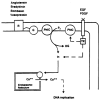Hepatic regeneration and growth factors
- PMID: 7684910
- PMCID: PMC3005256
- DOI: 10.1002/jso.2930530503
Hepatic regeneration and growth factors
Figures








References
-
- Michalopoulos G, Houck KA, Dolan ML, Luetteke NC. Control of hepatocvte replication by two serum factors. Cancer Res. 1984;44:4414–4419. - PubMed
-
- Goldberg M. Purification and partial characterization of a liver cell proliferation factor called hepatopoietin. J Cell Biochem. 1985;27:291–302. - PubMed
-
- Olsen PS, Boesby S, Kirkegaard P, et al. Influence of epidermal growth factor on liver regeneration after partial hepatectomy in rats. Hepatology. 1988;8:992–996. - PubMed
Publication types
MeSH terms
Substances
Grants and funding
LinkOut - more resources
Full Text Sources
